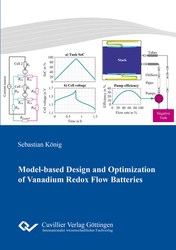| Departments | |
|---|---|
| Book Series (96) |
1377
|
| Nachhaltigkeit |
3
|
| Gesundheitswesen |
1
|
| Humanities |
2362
|
| Natural Sciences |
5405
|
| Engineering |
1789
|
| Engineering | 291 |
| Mechanical and process engineering | 861 |
| Electrical engineering | 685 |
| Mining and metallurgy | 30 |
| Architecture and civil engineering | 75 |
| Common |
97
|
|
Leitlinien Unfallchirurgie
5. Auflage bestellen |
|
Advanced Search
Model-based Design and Optimization of Vanadium Redox Flow Batteries (English shop)
Sebastian König (Author)Preview
Table of Contents, PDF (130 KB)
Extract, PDF (3.4 MB)
In this work, a holistic approach is used to develop a multi-physical model of the Vanadium Redox Flow Battery on a system level. The model is validated with experimental data from three flow battery manufacturers and is then deployed in an extensive parameter study for designing a flow battery cell. Using finite element analysis (FEA), twenty-four different cell designs are derived, which vary in electrode area and the design of the electrolyte inlet and outlet supply channels. The performance of the designs is then simulated in a single-stack and a three-stack string system.
The presented model is also deployed in a flow rate optimization study. Here, a novel strategy involving the model-based optimization of operation-points defined by state-of-charge and charging or discharging current is presented and compared to conventional flow rate control strategies. Finally, a stack voltage controller is introduced, which prevents the violation of cell voltage limits as long as the pump capacity is not fully utilized.
| ISBN-13 (Hard Copy) | 9783736996151 |
| ISBN-13 (eBook) | 9783736986152 |
| Final Book Format | A5 |
| Language | English |
| Page Number | 182 |
| Lamination of Cover | matt |
| Edition | 1. |
| Publication Place | Göttingen |
| Place of Dissertation | Karlsruhe |
| Publication Date | 2017-09-13 |
| General Categorization | Dissertation |
| Departments |
Electrical engineering
Energy engineering |
| Keywords | VRFB, Flow battery, Vanadium Redox Flow Battery, Model, Design, Simulation, Optimization, Flow rate control |








